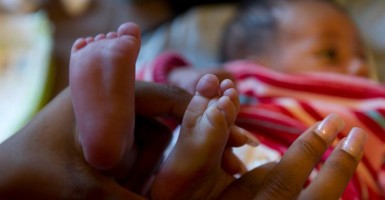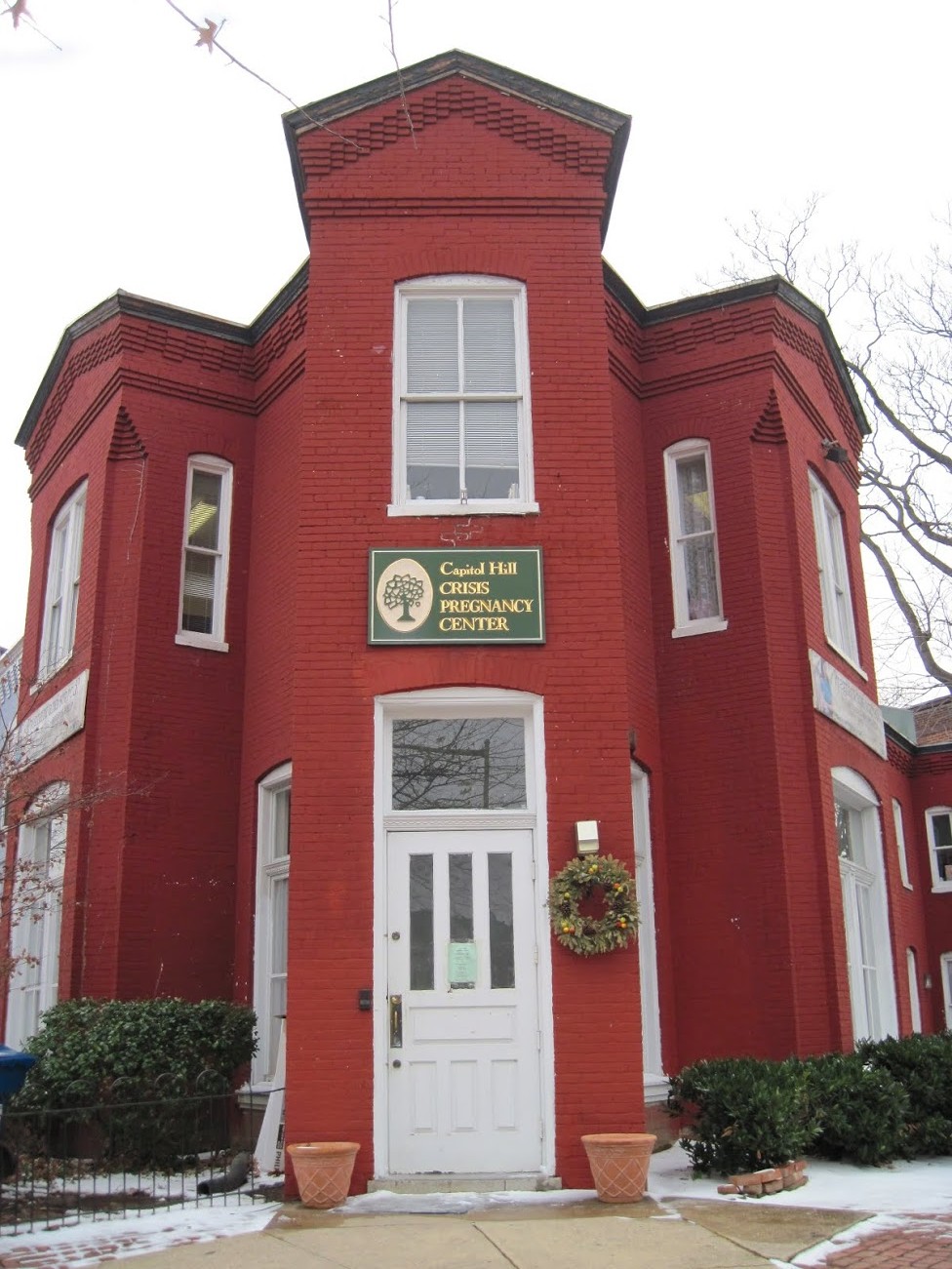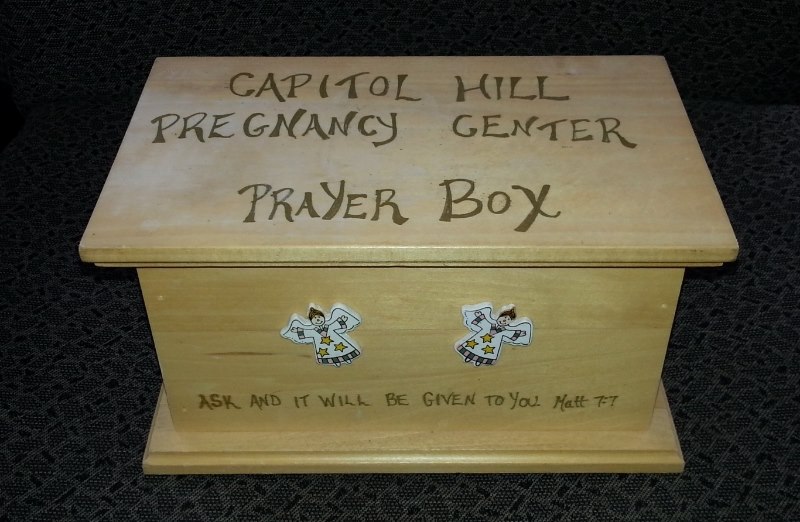“I’m in labor; pardon me,” Courtney says cheerfully, planting herself cross-legged in the armchair next to me.
She’s already been to the hospital, but it won’t admit her until she’s further along. A thin blonde, she is one of four young mothers living together in Borromeo House. The house, surrounded by a white picket fence in a residential part of Arlington, Va., is part of a nonprofit program that shelters girls between the ages of 16 and 22 and their children, who otherwise might be homeless.
Borromeo Housing was founded in 1988 by St. Charles Borromeo Catholic Church in Arlington. During the two-year program, the mothers are required to attend school and learn to save for their futures. It’s one of several free, privately administered resources for women dealing with unplanned pregnancies in the Washington D.C. area.
In 2010, pregnancy centers served more than 2.3 million women.
Borromeo Housing and other similar organizations provide women with a range of free services, including shelter, pregnancy tests and ultrasounds, clothing, childcare classes, counseling, diapers and other baby products. And unlike some similar government-funded resources, these charities often don’t require mounds of paperwork and documentation.

Borromeo’s Infant Care Supply Center houses diapers, formula and winter clothes for families. (Photo: Borromeo Housing, Inc. Facebook)
Pregnancy centers also discourage repeat unplanned pregnancies by providing information on the health risks women may face as a consequence. From 2001 to 2011, the abortion rate in the United States declined by four abortions per 1,000 women ages 15 to 44, according to The Heritage Foundation’s 2014 Index of Culture and Opportunity. The services pregnancy centers provide might help explain that decline.
Nationwide, there are at least 2,000 pregnancy resource centers. And that’s just counting the centers affiliated with the major U.S. networks—Care Net, Heartbeat International and the National Institute of Family and Life Advocates. The Family Research Center reports that, in 2010, these centers served more than 2.3 million women. This took the efforts of 71,000 volunteers, working for 5,705,000 uncompensated hours.
These centers rely on government aid for less than 10 percent of their funding, and 80 percent receive no public funding at all.
But the women of Borromeo House say most people don’t even know these programs exist. “There are a lot of options that moms aren’t really given,” says Courtney, who like others interviewed for this story did not want to give her last name. “I waited months for something like this to come up.”
Courtney, 18, grew up in Reston, Va. with her grandmother, after both her parents abandoned her. Her mother is a drug addict, whom Courtney hasn’t seen since she was 5 years old. She describes her as “extremely abusive.” Her father, an alcoholic, was unable to care for her and eventually also became violent.
At 15, Courtney was pregnant and in an abusive relationship. She hid the pregnancy from her grandmother and never went to the doctor.
“I was very emotionally unstable,” she recalls. She miscarried at 5 1/2 months. Just before her 16th birthday, she was pregnant again, by the same boyfriend. This time she miscarried at exactly five months—a consequence, she says, of not receiving proper medical attention for the first miscarriage. She knows both of their genders: Her first was a girl, her second a boy.
Shortly after the second miscarriage, Courtney attempted suicide. She was admitted to Dominion Hospital’s mental health facility in Falls Church, Va.
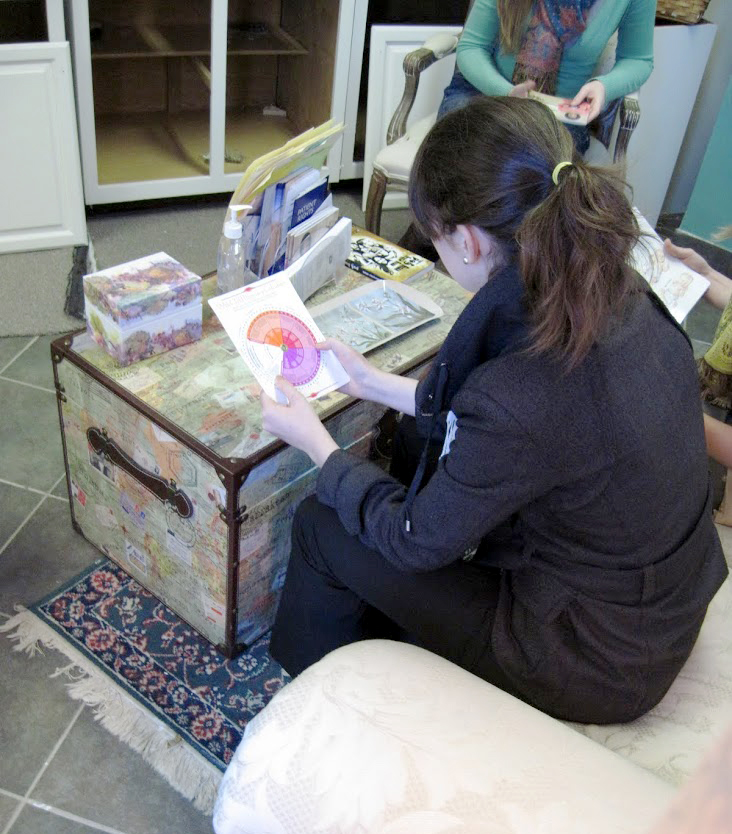
A counseling session at Capitol Hill Pregnancy Center. Here a client is using a timeline wheel to learn her approximate due date based on the dates she gave the counselor of the first day of her last menstruation. (Photo: Janet Durig)
As Courtney tells her story, another girl, Catnice (her middle name), has been sitting quietly on the couch, but here she interjects: “I did inpatient there,” she says of Dominion. “I didn’t have to stay, thank God, because the place reeked.”
“It was a living hell there,” Courtney agrees. She was in the inpatient facility for a month and a half and an outpatient for three weeks.
After she was released from Dominion, Courtney, by then a junior in high school, moved out of her grandmother’s house. She hoped that changing her living situation might help her recover. She moved in with her step-grandmother and uncle. But eventually her relationship with them frayed and they cut her off.
Under 18 and pregnant, she had nowhere to go—until she found Borromeo House.
Courtney then discovered she was pregnant for the third time, with a new boyfriend. She moved in with the 19-year-old boyfriend, into “a really terrible apartment building,” which she remembers as “kind of scary” and a place where she “couldn’t really go outside without my boyfriend being with me.” Soon after, the boyfriend quit school and lost his job. They ran out of money, and Courtney was still too young to be admitted to a homeless shelter. Until she found Borromeo House, she had nowhere to go.
Life at Borromeo House
Catnice, 21, was 14 the first time she became pregnant: “My mom held my hand,” she says of that time. But once she was 18 and living on her own, “I ended up not being stable, so I had to go to a shelter.” She was in and out of shelters for a while and not regularly attending school.
While living in a shelter, she found out she was pregnant again. She quit her job at Target after her bosses switched her from climbing ladders to cleaning bathrooms—neither recommended activities for a pregnant woman—and reduced her pay. Children are not allowed in most shelters, so after the birth she had no place to stay. She heard about Borromeo House from a school counselor.
Borromeo House uses a rigorous application and interview process that considers a range of factors, including status in school and interviews with counselors. Catnice was not accepted until the second time she applied. She moved in with her son when he was six months old. He’s just turned 1 year old and plays happily on the floor near his mom.
The Borromeo House program aims to teach mothers to be self-sufficient and stable parents. It claims 90 percent of its graduates become financially independent and do not have repeat unplanned pregnancies. While in this program, which is funded entirely by private donations, the moms do not rely on government programs such as WIC and food stamps.
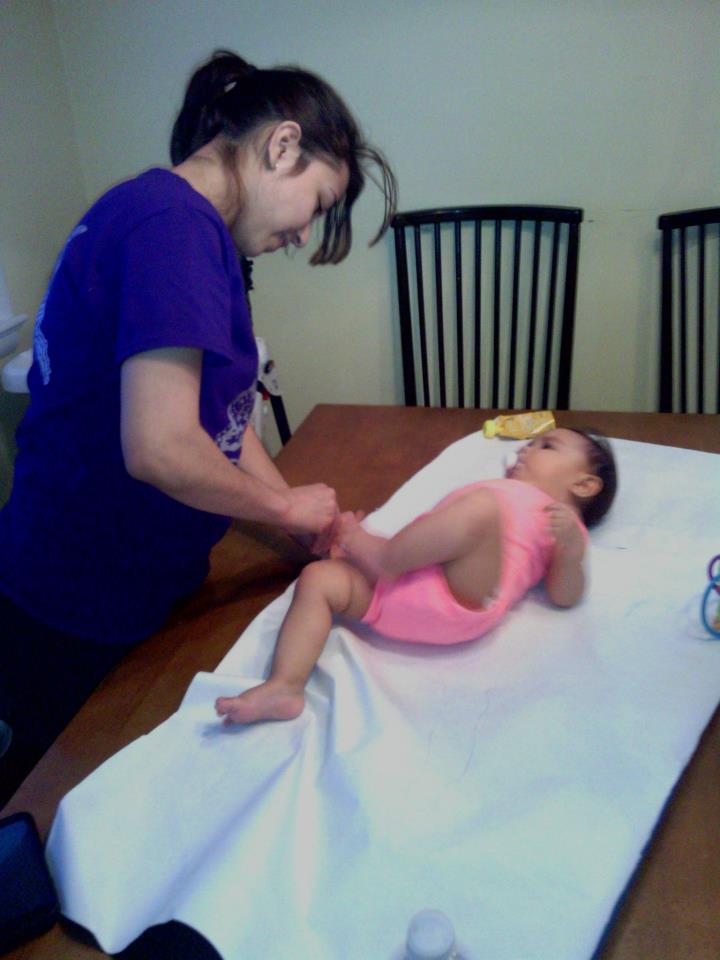
At a Group Night, the Borromeo House moms worked on a goal setting activity for the children. They drew an outline of their child, then wrote the goals they set for the children in the “body” of the drawing. (Photo: BHI Facebook)
The young mothers all have their own bedrooms and can have only one child living with them. Although they live mostly on their own, they share chores, have a curfew and attend group meetings on Mondays and Thursdays.
“It’s a place to live and grow and develop healthy relationships with people,” Catnice says. “Before my coming here, my attendance was crap, I wasn’t stable, my grades were really, really poor. Coming here has definitely made me a better person, and I’ve been more successful here than anywhere else.”
Although the residents occasionally have minor scuffles, Catnice describes her housemates as almost sisters. She’s about to graduate from high school and has a job lined up at an airport. She plans to attend Northern Virginia Community College (NOVA) for nursing and already has obtained her Certified Nursing Assistant certificate.
“She’s worked really hard to get there, too,” Courtney says of Catnice. They take a moment to reminisce together over the struggles of attending school while working and, occasionally, being homeless—the sleepless nights, the stress, the constant vomiting.
“It’s a place to live and grow and develop healthy relationships with people,” moms say of Borromeo House.
Courtney is also graduating from high school and hopes to take online classes at NOVA while her daughter is still an infant. She says she wants to study early childhood education and psychology. She’s still with the father of her child. “If I didn’t have this place, I don’t know what I would do.”
Although, of course, her more immediate concern is giving birth to her daughter. “I’ve been biting through the last four contractions,” she says after awhile.
Steps From the U.S. Capitol
Capitol Hill Pregnancy Center, another privately run resource for unplanned pregnancies, operates out of an old red brick building near Union Station in Washington, D.C. The sparse front room includes a desk with rows of gently used baby shoes in front of it.
Janet Durig, the director, is a curly blonde-haired woman bubbling with energy. She points the way downstairs, where stacks of labeled plastic bins hold every kind of baby clothing imaginable, arranged by season and size. In the next room are diapers, and in another room, high chairs and car seats. There is a small supply of maternity clothes, although never enough. Everything they get is donated, and everything they have is given away.
The pregnancy center offers everything from clothes and supplies to free childbirth classes.
Then there is the sitting room, where a young woman seeking advice on an unplanned pregnancy might meet with one of the center’s trained counselors. The couch and chairs are upholstered with white cloth, and a trunk serves as a coffee table. A tray on top of the trunk holds a pregnancy test with one stripe. “I can see somebody wasn’t pregnant,” Durig says, sweeping it into a trash bin.
Like most pregnancy centers, Capitol Hill Pregnancy Center was founded with the intention of counseling young girls who are thinking of having an abortion. But staffers say they see every kind of client: those who want to have an abortion and mistake the center for an abortion clinic, those who are trying to decide whether to have an abortion, and those who intend to keep their baby but need resources for their pregnancy. The center offers everything from clothes and supplies to free four-week childbirth classes.
“You want her to know if she chooses to keep her baby, we can help,” says Durig. “If you can’t help them all the way, then don’t help them.”
Tiana Venable was 17 the first time she came to the center. She was a high school senior from a well-off military family who lived in the Capitol Hill neighborhood. Her boyfriend at the time was a police officer, although he was a security guard when they met. “He was very friendly,” she recalls. But once they began a relationship, he started to abuse her—emotionally, physically and, at times, financially.
She attempted to hide her first pregnancy from her parents, but the pregnancy was ectopic—meaning the embryo had implanted outside the uterus, in her tubes. She was rushed to the hospital for emergency surgery and lost the child.
A few months later, she was pregnant again. She was terrified her parents would once more find out and went to the center seeking help and advice. The counselors prayed with her and assured her they would be there for her, whatever she decided. They told her God would always love her.
Tiana never forgot the unique sense of love she felt. “Other places made me feel like I was a bad person.”
Venable chose to abort the baby. She stayed with her boyfriend for several more years, too afraid of him to leave. He threatened her repeatedly and told her that, since he was a police officer, no one would believe her story if she reported him. Although her family and friends suspected she was in a bad situation, no one knew the extent of the abuse.
“I felt backed up against the wall,” she says. After she picked up his gun to defend herself, she realized how desperate her situation had become.
“This is not me,” she told herself. With encouragement from her grandmother, she finally took her chance and left him—although not before he raped her twice and left her pregnant once again. She was then a junior in college.
Her father pressed her to abort the child so she would have no ties to the man who had abused and raped her. In total she would have seven abortions.
Getting Help and Giving Back
Sometime later, as she was finishing up her degrees in developmental psychology and early childhood education, Venable needed to put in volunteer hours as part of her school courses. Her father suggested she return to the center that had helped her years ago. At first, she was reluctant. The thought of the center brought back too many memories.
But she had never forgotten the unique sense of love she felt at the center and how deeply it had affected her.
“Other places made me feel like I was a bad person.” At the center, “It was just warm hugs. Miss Janet loves to hug. That right there was just enough.”
Venable returned to the center, where she has volunteered for the past eight years. She started out doing counseling on Mondays but now teaches a parenting class on Thursday nights. She tells the women her story and lets them know they can ask her anything.
“A lot of them feel like nobody understands their situation,” she says. They’re shocked when they hear her story. “They’re like, ‘you live in a nice neighborhood, you’ve been to school—how could you go through that?’ I let them know it can be anybody. It breaks down that wall.”
Soon after Venable returned to the center, the staff asked her if she wanted to participate in a new program they were adding—a 10-week post-abortion healing class for women suffering from depression caused by Post Abortion Syndrome. Venable agreed, although she thought she would mostly be an observer. “I thought I had closure.” Once the class began, “There was so much that I really hadn’t let go of that was still in me that hurt.”
The class is primarily a Bible study, where the women share their personal testimonies and work through the healing process together. Venable eventually invited her mother to the class, where she finally was able to explain to her mother why she had aborted and ask for her forgiveness.
Capitol Hill Pregnancy Center offers a a 10-week post-abortion healing class for women suffering from depression.
At the end of the course, the women hold a final ceremony together. They receive a candle for each aborted child, name them, and release them to God, so they can have “a proper service.” Venable has since trained to become a counselor to lead the class.
Years after her first appointment, Venable found the card she had taken from the center on that first day, when she was 17, tucked in her diary.
“When I came back, I realized how they helped me,” she says.
Venable has been married for nearly five years and has two children. She hopes to start writing a book this summer. She wants people to understand the effect even a small look might have on a young woman’s health and well-being. She recalls the pain of going to doctors and having to tell them how many times she had been pregnant.
“At first, it used to hurt,” she says. “I never even wanted to say. I would just make up a number.”
Now, when she meets with young girls facing unplanned pregnancies, Venable treats them how she was treated on her first visit: She lets them know her thoughts on abortion but assures them that, no matter what, she will not desert them. “Because that’s what most people want to know: ‘If I do this, are people just going to hate me?’ Regardless, if you do it or not, I’m here.”
“We do not force our opinions on anyone,” says the director of a pregnancy center.
Many come to the center for the free pregnancy tests. Some want to talk to the counselors, but others simply take the test and leave. The center doesn’t pressure them to talk if they do not want to.
“We do not force our opinions on anyone,” says Durig, Capitol Hill Pregnancy Center’s director. “If they ask, we do tell them that we’re a faith-based organization, we do believe in life, but whatever their choices are, we just want to make sure they make an informed, educated decision.”
Some of their clients are teens whose mothers have thrown them out of the house for not having an abortion. “That happens more times than you can imagine,” Durig says, in between running up and down the stairs to answer the phone and direct clients to her staff.
Reconsidering Abortion
In 2008, Washington, D.C., had the fourth highest abortion rate in the country. Since D.C. does not require any parental involvement for a minor to obtain an abortion, some abortions are performed on girls from states with stricter abortion laws.
Durig says it’s also common for local girls as young as 16 to come to the center already having had six abortions. For girls like this, for whom abortion may be the only form of birth control they know, the center has piles of information on pregnancy. “It gives us an opportunity to say, ‘Would you like to know how that is damaging your body?’”
Durig estimates that 85 percent of Capitol Hill Pregnancy Center’s clients come in considering an abortion, but 87 percent leave choosing to keep the baby.
The center also provides information on HIV and directs clients to free clinics for testing. The rate of HIV infection in Washington, D.C., rivals that of some developing countries.
The center, founded 29 years ago, relies on Durig, its only full-time employee, seven part-timers and an array of 25 to 30 volunteers and interns. Some volunteers take counseling training to answer phones or meet with clients. Others simply come in for a few hours to sort and fold baby clothes. CHPC belongs to both Heartbeat International and Care Net, the two major umbrella organizations that support most of the thousands of pregnancy centers in the United States through information and training.
85 percent of clients come in considering an abortion, but 87 percent leave choosing to keep the baby.
Last year, Capitol Hill Pregnancy Center saw 2,400 clients, 96 percent of whom were between the ages of 14 and 20. The youngest client ever to ask for a pregnancy test was 11. The youngest who came in pregnant was 12.
Durig is full of stories of the women who come to the center. She tears up as she recalls one young woman, a drug addict who would prostitute herself in exchange for a hot shower or a place to sleep. Years later she would return to visit, fully recovered and married to a successful man who was a leader in her local church.
“We never tell people what to do,” Durig says, “but we guide them into thinking outside the box that they’re in right now.” If a girl has been kicked out of her parents’ house, a counselor might help her think through other relatives and friends she could turn to. If she has to drop out of school to carry a child, Durig might know of part-time or correspondence programs that could fit her needs.
Monique Johnson was 19 when she had her first child. She was in school but couldn’t find a job or provide for her infant. Finally, she turned to D.C. Healthy Families, which referred her to Capitol Hill Pregnancy Center. They set her up with “anything and everything,” she says. “Everything was provided.”
Johnson describes the center as “that glue that makes everything stick.” And she liked that she wasn’t inundated with red tape. “It’s welcoming. You don’t feel like anybody here is judging you or judging your lifestyle.”
She came to the center for two years until she finally found work and was able to support herself. Her son is about to turn 4, and she also has a 9-month-old. She’s going back to school for a one-year stationary engineering program. She now donates to the center and just began training to volunteer. She hopes to eventually help out in the parenting classes. “It gets to the point where once you’ve been helped so much, you want to give back. That’s what keeps it going.”
“It’s welcoming. You don’t feel like anybody here is judging you or judging your lifestyle.”
Capitol Hill Pregnancy Center continuously expands its programs and resources—its post-abortion counseling program, for example, is still relatively new, and Durig says she has been surprised by the overwhelming demand for it. Durig regularly gives speeches at churches where she mentions this program.
Not once, she says, has she left anywhere without at least one woman approaching and whispering to her: “I had an abortion in high school, and nobody knows it. My parents don’t even know. My husband and kids don’t know. Can I call you?”
Capitol Hill Pregnancy Center plans to publish its program so other centers can start their own courses.
Durig is in the midst of navigating loans for the building and appears constantly busy with paperwork and fundraising. On top of that, she welcomes all clients to drop by any time and talk to her, with no need to make an appointment. She tells them if they see her car outside to come on in.
If you ask those at Borromeo House or Capitol Hill Pregnancy Center why so few people know about the work these private groups do, they shake their heads sadly or tell you how blessed they were to find them.
“The thing they tell you the most,” Durig says, “is ‘I no longer feel like I’m in this alone.’”
This article has been modified.




























